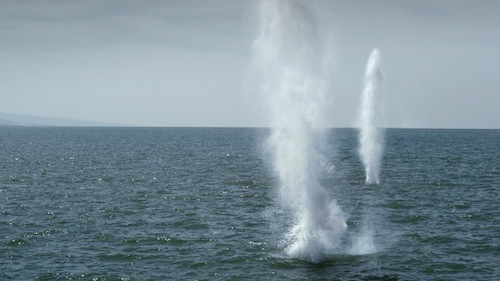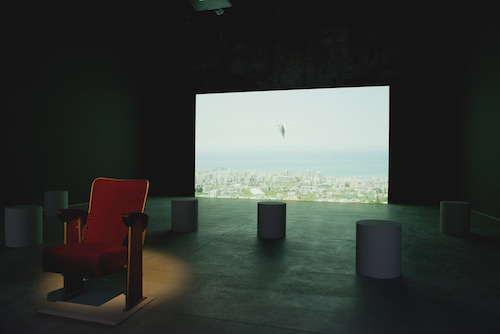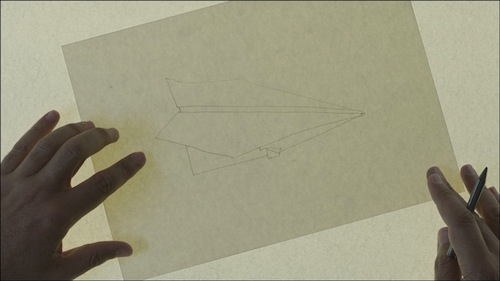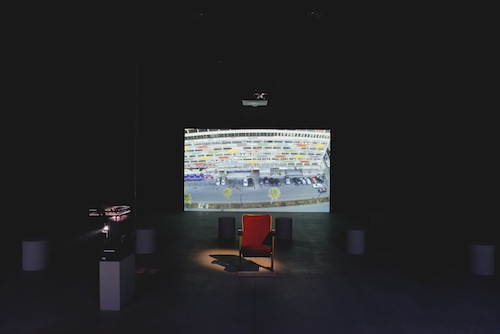
Akram Zaatari. “Letter to a Refusing Pilot (still),” 2013. Film and video installation. Courtesy the artist and Sfeir-Semler Gallery Beirut.
Stories can have a life of their own. They are told, heard, told again, written down, archived, recorded, and gathered together with supporting documents, photographs or film. A story, especially in the context of war, can fragment, multiply, and turn into a series of contractions. The veracity of a story’s truth becomes increasingly elusive when one has to choose between an individual’s partial understanding of a situation and the unreliable grand narratives told to us by power brokers who are first and foremost driven by ideology. This condition haunts many of the artworks that have emerged in Beirut these past twenty years.

Akram Zaatari. “Letter to a Refusing Pilot (still),” 2013. Film and video installation. Courtesy the artist and Sfeir-Semler Gallery Beirut.
Here’s one story: In 1982, Israel invaded and occupied southern Lebanon, inserting yet another violent complication into an already protracted civil war. Part of this incursion included fighter jets sent to bomb a set of targets. One of these planes was sent near Ain El-Helweh, a Palestinian refugee camp just south of the port town Saida. As the plane approached the target, the pilot recognized the building as a school that he had attended as a child. He swerved away and headed toward the sea where he dropped three bombs into the water. A few hours later another pilot destroyed the school. This story soon swirled around southern Lebanon—a rumor that acquired a wide array of mythological flourishes.

Akram Zaatari. “Letter to a Refusing Pilot,” 2013. Installation view, Lebanese Pavilion, 55th International Venice Biennale. Photo: Marco Milan.
Akram Zaatari’s Letter to a Refusing Pilot, a film and video installation at the Venice Biennale that combines archive and allegory, is based on this story. The artist’s father was principal of the aforementioned school. Zataari grew up in Saida and in 1982 found himself standing on a balcony watching Israeli warplanes bomb the nearby hillside. He was learning to use his father’s Kiev camera and captured images of smoke billowing up from between the cedars on the horizon. Letter to a Refusing Pilot combines the intimate, quiet playfulness of adolescents with a violent rupture emanating from the sky.
The installation includes a large video projection, a looped 16 mm film, and an empty theater seat. The video begins with a camera mounted on a drone that rises from the roof of a building. It cuts to black and white aerial shots of architecture and then a lightbox. As the light is turned on, florescent tubes flicker on around the room of the installation; it is as if the viewer is in or on the box, complicit with the narrative on the screen. A pair of hands with white gloves moves a set of photos across the backlit surface. We see family snapshots of a woman posing with two kids, a mother helping a toddler to pet a dog and a teenager mugging for the camera. Then the hands take a piece of white paper and make a couple of pencil line drawings on paper, an enigmatic structure fills one, and another seems to be a image of two trees in front of a building. A school bell rings and the next drawing is of a paper airplane.

Akram Zaatari. “Letter to a Refusing Pilot (still),” 2013. Film and video installation. Courtesy the artist and Sfeir-Semler Gallery Beirut.
Students line up for school under the watchful gaze of a teacher. They chatter amongst themselves as they rush through the halls and into their classrooms. Images of a typical day at school soon turn to a group of boys that run through the streets, into a building, up its stairs, finally climbing onto the roof. There they carefully fold paper airplanes from marked up exam papers. When they are done, their paper airplanes are lofted off the roof, fluttering in the breeze and floating slowly on their tiny winged expanse towards the ground. At one point another group of boys fold and fly some more but this time the paper airplanes gather and converge like jet planes in formation. An innocuous game turns quickly into a militaristic gambit and a boyhood fantasy intersects with the roar of jet engines and an Israeli commander’s voice barking orders over a radio.

Akram Zaatari. “Letter to a Refusing Pilot,” 2013. Installation view, Lebanese Pavilion, 55th International Venice Biennale. Photo: Marco Milan.
Lebanon is a complicated place, and Israeli military incursions have continued beyond this moment in 1982. But in each case there have always been multiple vantage points. The 16mm film pans across the photographs that the young Zataari took in the middle of one war. But many have continued to watch as geopolitics unfurl from the fabric of their everyday lives. The refusal of one pilot is yet another vantage point and his resistance both echoes and is radically different from that of the Palestinian and Lebanese below him. But these perspectives echo one another, whether it’s through the lens of a camera or a soldier’s crosshairs.
Zaatari’s chair in Letter to a Refusing Pilot waits for the soldier—inviting him to look through his eyes, his photographs, his film, and his stories, gathering together the fragmented truths that continue to confound each perspective.
Noah Simblist is Blogger-in-Residence through July 30, 2013.




Pingback: You won’t believe the one weird trick that I used to come up with this list of 29 zeitgeisty artists. | Benjamin Lima